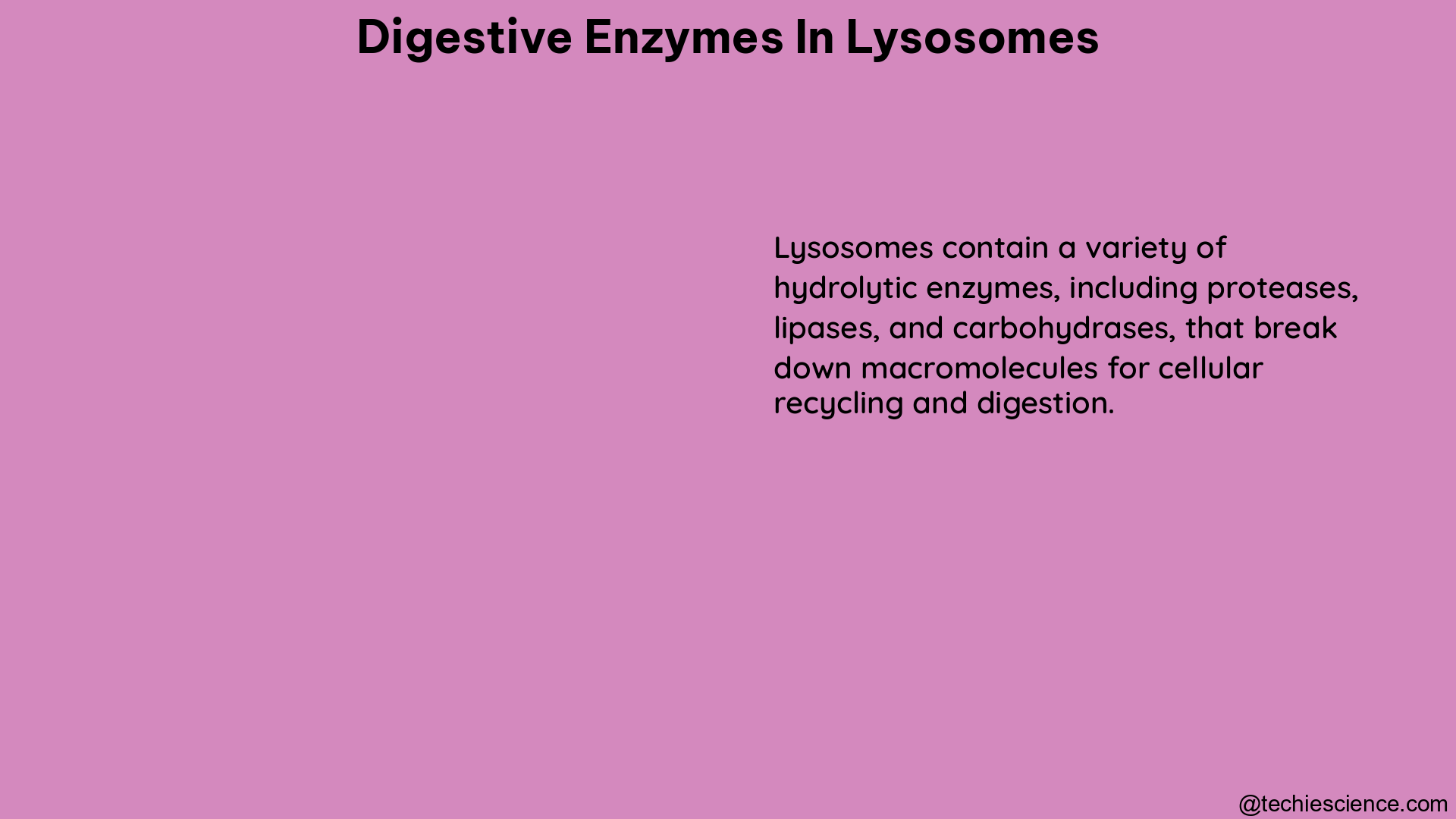Lysosomes are the cellular organelles responsible for the degradation and recycling of various macromolecules, including proteins, lipids, and nucleic acids. At the heart of this process are the digestive enzymes found within the lysosomal lumen, which play a crucial role in the cell’s waste disposal system. These enzymes, collectively known as lysosomal hydrolases, are capable of breaking down a wide range of biomolecules into their smaller components, enabling the cell to recycle and reuse these building blocks.
The Diverse Repertoire of Lysosomal Digestive Enzymes
Lysosomes contain a vast array of digestive enzymes, with over 50 different hydrolases identified to date. These enzymes can be broadly classified into the following categories:
-
Proteases: These enzymes are responsible for the breakdown of proteins into smaller peptides and amino acids. Examples include cathepsins, pepsin, and trypsin.
-
Glycosidases: These enzymes target the glycosidic bonds in carbohydrates, breaking them down into monosaccharides. Examples include α-amylase, β-galactosidase, and α-L-iduronidase.
-
Phosphatases: These enzymes catalyze the hydrolysis of phosphate esters, releasing inorganic phosphate. Examples include acid phosphatase and alkaline phosphatase.
-
Sulfatases: These enzymes hydrolyze sulfate esters, releasing sulfate ions. Examples include arylsulfatase A and B.
-
Nucleases: These enzymes are responsible for the degradation of nucleic acids, such as DNA and RNA, into their constituent nucleotides. Examples include deoxyribonuclease and ribonuclease.
-
Lipases: These enzymes target the ester bonds in lipids, breaking them down into fatty acids and glycerol. Examples include acid lipase and sphingomyelinase.
The specific composition of lysosomal digestive enzymes can vary depending on the cell type and the physiological needs of the organism. This diversity ensures that lysosomes can effectively break down a wide range of macromolecules, enabling the cell to recycle and reuse these essential building blocks.
Quantifying Lysosomal Digestive Enzyme Activity

Measuring the activity of lysosomal digestive enzymes is crucial for understanding the function and regulation of these organelles. Several methods have been developed to quantify the activity of these enzymes:
1. Enzymatic Activity Measurements
One common method to quantify the activity of lysosomal hydrolases is by measuring their enzymatic activity in the cytosol after digitonin extraction. Digitonin is a detergent that selectively permeabilizes the lysosomal membrane, allowing the release of the lysosomal contents into the cytosol. By measuring the enzymatic activity of the released hydrolases, researchers can assess the degree of lysosomal membrane permeabilization (LMP), which is a hallmark of lysosomal cell death.
2. Fluorogenic Substrate Assays
Another approach to quantify lysosomal enzyme activity is by using fluorogenic substrates. This method involves the extraction of the cytosol using digitonin, followed by the measurement of lysosomal hydrolase activities in the extracted cytosol and the total cellular lysate. The hydrolases cleave the fluorogenic substrate, releasing a fluorescent signal that can be detected and quantified. This assay can be used to determine the amount of lysosomal hydrolases released into the cytosol, providing a measure of LMP.
3. Time-Lapse Imaging of Lysosomal Membrane Permeabilization
Lysosomal membrane permeabilization can also be monitored in real-time using time-lapse imaging. In this approach, the lysosomes are loaded with fluorescent dextran, a large molecule that is normally retained within the lysosomal lumen. As the lysosomal membrane becomes permeabilized, the fluorescent dextran is released into the cytosol, allowing the visualization of the LMP process. This method also enables the determination of membrane pore sizes by applying different sizes of dextran.
4. Ratiometric Fluorescence Measurement of Lysosomal pH
Lysosomal pH is a critical parameter that influences the activity of the digestive enzymes within these organelles. To assess lysosomal pH, researchers have developed genetically-encoded probes that utilize ratiometric fluorescence. These probes typically consist of a lysosomal protein tagged with a pH-sensitive fluorescent protein, such as a variant of GFP, and a pH-insensitive fluorescent protein, like mCherry. By measuring the ratio of the two fluorescent signals, the lysosomal pH can be determined with high accuracy over extended periods of time, from hours to days.
Insights into Lysosomal Function and Regulation
The methods for quantifying lysosomal digestive enzyme activity provide valuable insights into the function and regulation of these organelles. By understanding the activity and localization of the various hydrolases, researchers can gain insights into the following:
-
Lysosomal Dysfunction and Disease: Alterations in the activity or localization of lysosomal digestive enzymes have been implicated in various lysosomal storage disorders, neurodegenerative diseases, and cancer. Quantifying enzyme activity can help identify the underlying causes of these diseases and guide the development of targeted therapies.
-
Autophagy and Cell Death: The release of lysosomal hydrolases into the cytosol, as measured by LMP, is a key event in the process of lysosomal cell death, also known as lysosome-dependent cell death or “lysoptosis.” Understanding the regulation of LMP can provide insights into the role of lysosomes in programmed cell death pathways.
-
Lysosomal Biogenesis and Trafficking: The activity and localization of lysosomal digestive enzymes can serve as markers for the biogenesis, maturation, and trafficking of lysosomes within the cell. This information can help elucidate the complex mechanisms that govern lysosomal dynamics and their integration with other cellular processes.
-
Nutrient Sensing and Signaling: Lysosomal pH and the activity of digestive enzymes are closely linked to the cell’s nutrient sensing and signaling pathways, such as the mTOR (mechanistic target of rapamycin) pathway. Monitoring these parameters can provide insights into how cells adapt to changes in nutrient availability and environmental conditions.
By leveraging the various methods for quantifying lysosomal digestive enzyme activity, researchers can gain a deeper understanding of the critical role these organelles play in cellular homeostasis, waste management, and signaling pathways. This knowledge can ultimately lead to the development of novel therapeutic strategies for the treatment of lysosomal-related diseases.
References:
- Appelqvist, H., Wäster, P., Kågedal, K., & Öllinger, K. (2013). The lysosome: from waste bag to potential therapeutic target. Journal of molecular cell biology, 5(4), 214-226.
- Boya, P., & Kroemer, G. (2008). Lysosomal membrane permeabilization in cell death. Oncogene, 27(50), 6434-6451.
- Perera, R. M., & Zoncu, R. (2016). The lysosome as a regulatory hub. Annual review of cell and developmental biology, 32, 223-253.
- Settembre, C., Fraldi, A., Medina, D. L., & Ballabio, A. (2013). Signals from the lysosome: a control centre for cellular clearance and energy metabolism. Nature reviews Molecular cell biology, 14(5), 283-296.
- Xu, H., & Ren, D. (2015). Lysosomal physiology. Annual review of physiology, 77, 57-80.

Hi….I am Anushree Verma, I have completed my Master’s in Biotechnology. I am a very confident, dedicated and enthusiastic author from the biotechnology field. I have a good understanding of life sciences and great command over communication skills. I thrive to learn new things every day. I would like to thank this esteemed organization for giving me such a great opportunity.
Let’s connect through LinkedIn- https://www.linkedin.com/in/anushree-verma-066ba7153